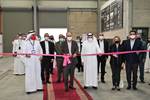IsoTruss receives EPA funding for R&D in fiber-reinforced concrete foundations
Eco-friendly concept increases resiliency and energy absorption, decreases installation time and costs for use in telecommunication tower infrastructure.

Photo Credit: IsoTruss Inc.
IsoTruss Inc. (Springville, Utah, U.S.), an engineering, design and manufacturing services provider, has earned a $100,000 funding award from the U.S. Environmental Protection Agency (EPA)’s Small Business Innovation Research (SBIR) Program. The Phase 1 award will be applied towards research and development (R&D) of a fiber-reinforced concrete foundation for the company’s carbon fiber lattice cell telecommunication towers— 12 times stronger than steel and offering 70% reduction in carbon emissions — to increase resiliency to natural disasters. Future entry into other applications such as roads, bridges and buildings is expected.
“Infrastructure must become safer, longer lasting and more sustainable,” notes Nathan D. Rich, IsoTruss CEO. “With this grant from the EPA, we can move forward in developing an eco-friendly composite-reinforced concrete foundation aimed at improving resiliency while decreasing construction time and costs compared to traditional solutions.”
The proposed IsoTruss-reinforced concrete foundation aims to improve the resiliency over steel-reinforced concrete by better combining the axial and shear strength of the reinforcement, providing more energy absorption and allowing IsoTruss-reinforced concrete to be rated to withstand higher loading conditions.

IsoTruss telecommunication tower base.
Moreover, the fiber-reinforced concrete indicates advantages in terms of decreased installation costs and time. IsoTruss successfully tested the concept with a foam foundation pilot deployment for a commercial customer; per the test, installation costs were reduced by 60% compared to a typical tower foundation.
“This solution will be timely for telecom tower owners with the transition to 5G networks in the U.S. that will increase tower density by approximately 10 times, leading to a total addressable market of $75 billion,” adds Cromwell Wong, COO, IsoTruss Inc.
The company was one of 30 small U.S. businesses to receive EPA funding to develop novel technologies to address pressing environmental and public health problems.
Related Content
-
21st century concrete: composite metamaterial with super compressability, energy harvesting
Material comprising 3D-printed, auxetic, reinforced polymer lattices in conductive cement matrix can compress up to 15% and generate electricity for lightweight, mechanically tunable structures with energy harvesting and sensing.
-
Fiberglass conduit manufacturer grows into new products, infrastructure applications
Texas-based Champion Fiberglass, a five-time CW Top Shops honoree, expands its success in the fiberglass composite conduit market into new applications and products, looking toward future automation and sustainability initiatives.
-
Composite SIPs for more affordable, efficient and sustainable buildings
LiteSIP panels and modules enable framing in days, cutting structural labor and total cost by up to 70% and 30%, respectively, while increasing energy efficiency and durability.















